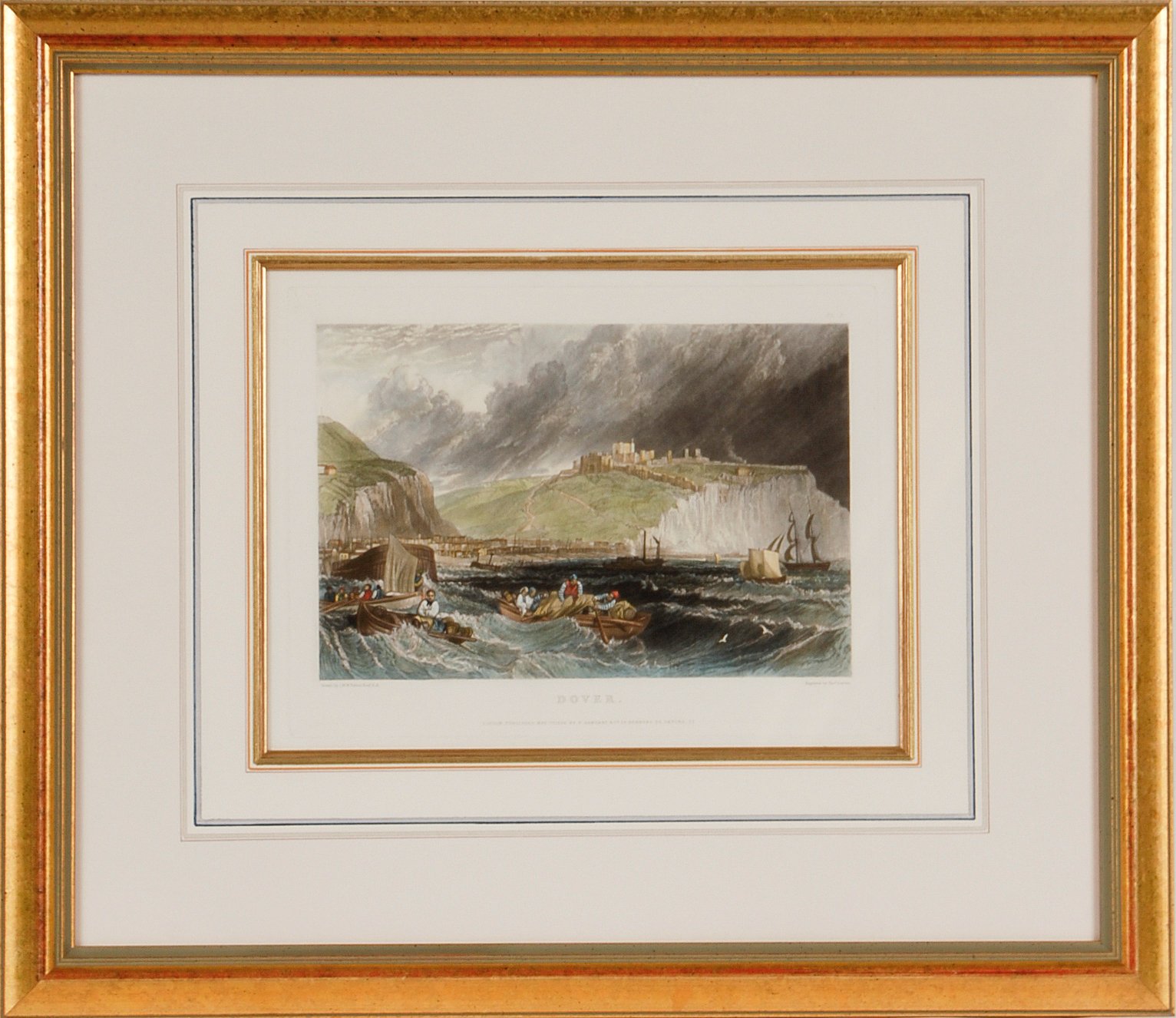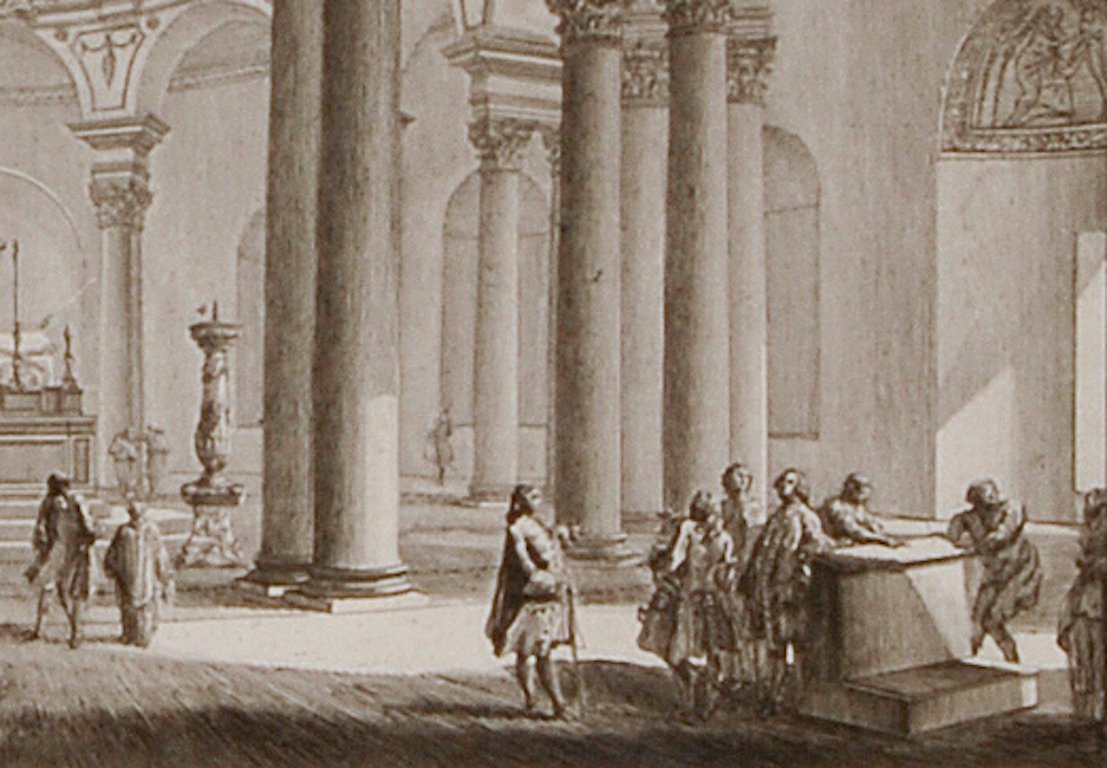A View of Dover, England: A Framed 19th C. Engraving After J. M. W. Turner
This beautiful 19th century framed engraving "Dover" by Thomas Lupton is based on an original painting by the renowned British artist J.M.W. Turner, which depicts a panoramic view of the harbor of Dover, a town in southeastern England, that has been an important port for centuries. The engraving captures the dramatic sky and sea that Turner was known for, with billowing clouds and waves crashing against the shore. The town and its famous white cliffs are visible in the background, while ships and boats dot the harbor in the foreground. Several wooden rowboats carrying multiple men are seen in the rough water, with the suggestion of storm clouds in the background. Lupton's engraving, created in the mid-19th century, was a popular way for people to appreciate Turner's artwork before the advent of photography and widespread reproduction techniques.
Creator: After J.M.W. Turner (1775 - 1851, British)
Creation Year: 1859
Dimensions: Height: 18 in (45.72 cm)
Width: 20.5 in (52.07 cm)
Depth: 1 in (2.54 cm)
Medium: Engraving
Condition: See description below.
This beautiful 19th century framed engraving "Dover" by Thomas Lupton is based on an original painting by the renowned British artist J.M.W. Turner, which depicts a panoramic view of the harbor of Dover, a town in southeastern England, that has been an important port for centuries. The engraving captures the dramatic sky and sea that Turner was known for, with billowing clouds and waves crashing against the shore. The town and its famous white cliffs are visible in the background, while ships and boats dot the harbor in the foreground. Several wooden rowboats carrying multiple men are seen in the rough water, with the suggestion of storm clouds in the background. Lupton's engraving, created in the mid-19th century, was a popular way for people to appreciate Turner's artwork before the advent of photography and widespread reproduction techniques.
Creator: After J.M.W. Turner (1775 - 1851, British)
Creation Year: 1859
Dimensions: Height: 18 in (45.72 cm)
Width: 20.5 in (52.07 cm)
Depth: 1 in (2.54 cm)
Medium: Engraving
Condition: See description below.
This beautiful 19th century framed engraving "Dover" by Thomas Lupton is based on an original painting by the renowned British artist J.M.W. Turner, which depicts a panoramic view of the harbor of Dover, a town in southeastern England, that has been an important port for centuries. The engraving captures the dramatic sky and sea that Turner was known for, with billowing clouds and waves crashing against the shore. The town and its famous white cliffs are visible in the background, while ships and boats dot the harbor in the foreground. Several wooden rowboats carrying multiple men are seen in the rough water, with the suggestion of storm clouds in the background. Lupton's engraving, created in the mid-19th century, was a popular way for people to appreciate Turner's artwork before the advent of photography and widespread reproduction techniques.
Creator: After J.M.W. Turner (1775 - 1851, British)
Creation Year: 1859
Dimensions: Height: 18 in (45.72 cm)
Width: 20.5 in (52.07 cm)
Depth: 1 in (2.54 cm)
Medium: Engraving
Condition: See description below.
This colorful 19th century engraving is presented in a gold-colored wood frame and a cream-colored French mat highlighted with a light blue band and thinner mustard and gold-colored bands. There is a gold-colored fillet which further embellishes the engraving. The frame measures 18" high, 20.5" wide and 1" deep. The engraving, frame and mat are in excellent condition.
This engraving is held by several museums and institutions, including: The British Museum, The Metropolitan Museum. The Tate Museum, The Victoria and Albert Museum and The Yale Center for British Art.
Joseph Mallord William (J.M.W.) Turner (1775-1851) was an English painter who is widely considered one of the greatest landscape painters in Western art history. Born in London, he showed a remarkable talent for art from a young age, and studied at the Royal Academy of Arts from the age of 14. He quickly gained recognition for his watercolor landscapes, which were highly innovative and expressive. Turner's style evolved over time, and he became increasingly interested in the effects of light and color. He traveled extensively throughout Europe, and his experiences of the natural world, particularly the sea and the sky, had a profound influence on his art. His paintings are known for their luminosity, atmospheric effects, and dramatic use of color. Despite facing criticism and ridicule from some of his contemporaries, Turner continued to push the boundaries of art, experimenting with new techniques and styles throughout his career. He was a prolific artist, creating thousands of paintings, sketches, and watercolors, and his legacy continues to inspire artists today.
Edward Goodall (1795-1870) was a renowned English landscape and portrait painter, widely recognized for his exceptional talent and meticulous attention to detail. Goodall's interest in landscapes eventually extended to portraiture, and he gained recognition for his ability to depict the unique character and expressions of his subjects. His portraits possessed a remarkable depth and realism, capturing not just physical appearances but also the inner emotions and personalities of the individuals he painted. In addition to his prowess as a painter, Goodall was also an accomplished etcher, engraver, and illustrator. His works were often featured in prominent publications of the time, including illustrated books and periodicals. His intricate engravings showcased his exceptional technical skill and contributed to the dissemination of his artistic vision to a wider audience. Edward Goodall's talent and dedication earned him considerable acclaim during his lifetime. He exhibited his works at the Royal Academy and other prestigious art institutions, garnering praise for his exceptional technique and artistic sensibility. His contributions to the art world were also recognized through his appointment as a member of the Royal Society of Painters and Etchers. Today, Goodall's paintings and engravings continue to be cherished for their beauty and historical significance. They provide a window into the landscapes and society of the 19th century, capturing a fleeting moment in time with remarkable skill and artistry.


































